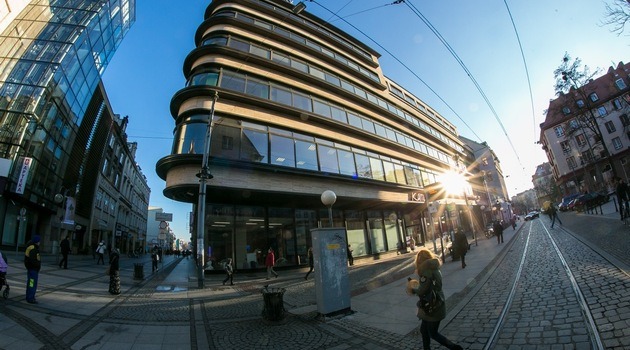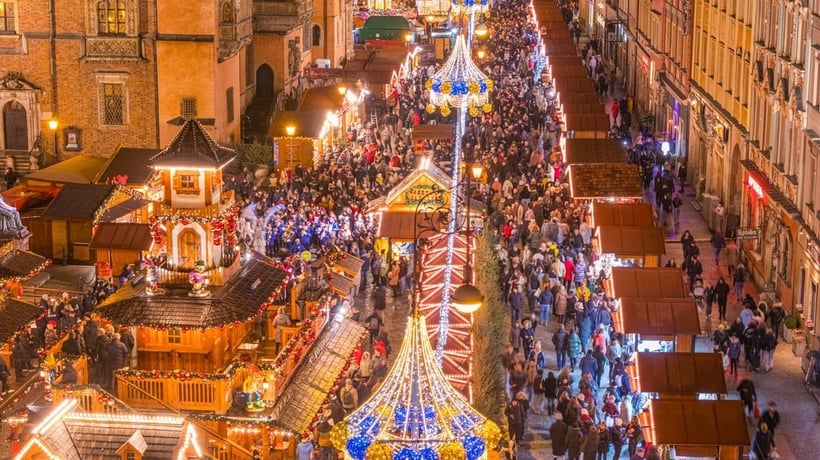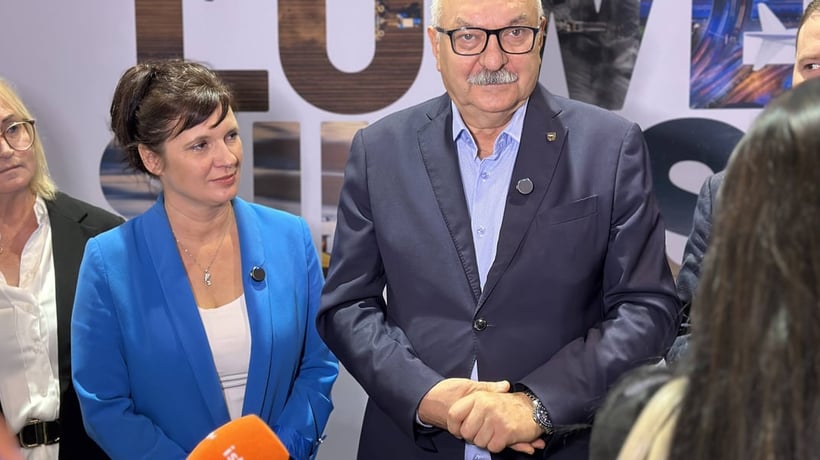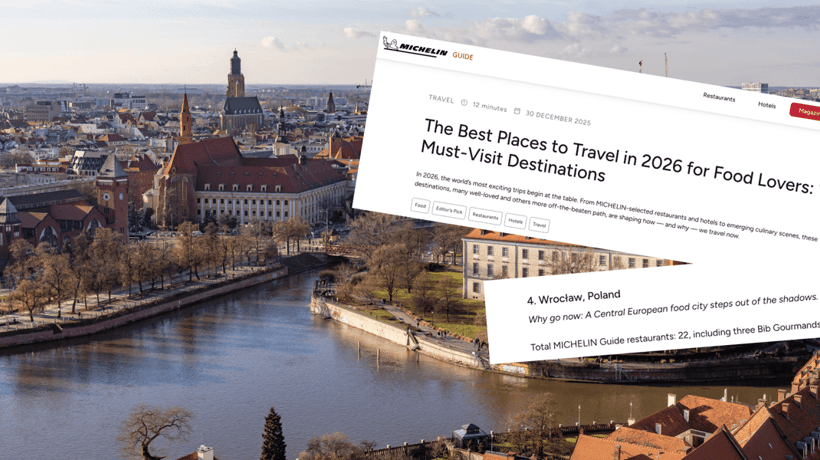Tomasz Wysocki: Lower Silesia is said to be the richest region in Poland in respect of the quantity and diversity of stones used in architecture. Can this abundance be seen in Wroclaw? Professor Marek Lorenc: There are hundreds of buildings in Wroclaw where stone was used for construction works. Please remember that Lower Silesia formally comprised a part of the Opole region when they were erected. Apart from that, stone was imported also from German or Czech regions situated right beyond the Polish border.

Professor Marek Lorenc from the Institute of Landscape Architecture; photo: Tomasz Walków
Today the assortment of available stones is very large, rich and diverse, indeed. Their sources are mainly the Sudetes and their foreland. These are the areas with a very complex geological structure. The second largest Polish region in terms of stone output is the Carpathians with an abundance of sandstones, and the third one is the Świętokrzyskie Mountains – the limestones excavated there cannot be found anywhere else.Let’s come back to Wroclaw and take a walk down the bridges and streets close to the popular buildings where stones from Lower Silesia were used.- Bridges are interesting objects. The Zwierzyniecki Bridge is an example of the use of very characteristic red sandstone from Słupiec – Nowa Ruda, which is a stone of excellent quality. Just see how many sophisticated pieces of sculpture designed by Klimm and Püddemann have survived there till today. Although more than hundred years have passed since it was built, Art Nouveau decorations still have rugged shapes, which proves best how strong and resistant to weather conditions this stone is. This is a model example of the use of Nowa Ruda sandstone.

The Zwierzyniecki Bridge; photo: Tomasz Walków
Very popular sandstones are those from the areas of Bolesławiec, Żerkowice, Wartowice, Warta Bolesławiecka, Czaple and Skała. This stone can be recognised even from a distance; it looks nice and is most often yellow. In Wroclaw, it was used, for example, for making an entrance and a portal in the building of NOT (Polish Federation of Engineering Associations) at ul. Piłsudski. It is a classic example of beautiful sandstone and its fine processing.

The building of NOT; photo: Tomasz Walków
The same sandstone was used for making the Walka i Zwycięstwo (Fight and Victory) fountain on Pl. Jana Pawła II square. Another equally popular material is the bright, almost white sandstone from Radków, which you can see in facings of entrance portals and facades of the building of the Provincial Office erected on the embankment of the Oder River between Grunwaldzki and Most Pokoju bridges.

Walka i Zwycięstwo (Fight and Victory) fountain; photo: Tomasz Walków
Granite pillars of Klimm
Lower Silesia is a huge basin of granite with the most famous mines in Strzelin and Strzegom areas. How much do they differ? - First of all, they differ in terms of grain-size distribution and colour. Strzelin granite is fine-cristalline and grayish with a slightly bluish shade. Granite from the Strzegom – Sobótka basin consists of large crystals with a slight yellowish and olive shade. But we must remember that both of these regions abound in quarries of various sizes where stone has slightly different structural and colour characteristics – sometimes they can be very different from the most typical ones.
In Wroclaw, various sorts of granite – including Strzegom granite – are present in the form of cobblestones on many streets. The most original products made of Strzegom granite include commemorative decorative border posts designed by Karl Klimm at the beginning of the 20th century. Out of six posts existing before 1945, only three and a fragment of the fourth one have survived till today. The granite from the Strzegom region was also used for building the facade of the building of the National Bank of Poland at ul. Lelewela.

A border post; photo: Tomasz Walków
Strzelin granite is exposed less prominently in Wroclaw buildings, but it forms, for example, the entire 19th-century stone terrace in the centre of Młyński bridges in Wroclaw. An interesting example of the use of granite is the Grunwaldzki Bridge. A larger part of this bridge is made of Strzegom granite, but it consists mainly of the structural mass, bases and everything that is buried in the ground on both banks. And what can we see? Decorative slabs of Karkonosze granite.

The Grunwaldzki Bridge; photo: Tomasz Walków
The last one is also visible on facades of some buildings, for example, the Lothus hotel at ul. Wita Stwosza. Apart from that, it covered the walls of the Świdnickie Passage and is exposed in a particularly fine manner on the wall of the southern underground passage under Pl. Dominikański square, from the side of the building of PZU (Polish Insurance Group).Today, it is no longer exploited in Poland. - It is exploited in small quantities only on the Czech side of Karkonosze Mountains. In the aforementioned underground passage on Pl. Dominikański square, from the side of the building of PZU, fine-grained black granite from Przedborowa was also used, although it is not granite in the strict sense in petrographic terms. Unfortunately, it does not look good – it has awful effusions resulting from acid rains. In the same place, stairs were made of Strzegom granite. If the passage had not been destroyed, it would serve as an interesting representation of various Lower Silesian rocks.

The southern passage under Pl. Dominikański square; photo: Tomasz Walków
We must not forget about marbles that occur in public spaces, too. - Of course. In Wroclaw, we can come across marbles from Sławniowice in the Opole region, from Przeworno near Strzelin and “Marianna” from Stronie Śląskie. Marble from Sławniowice was used for making many sculptures and epitaphs in the Wroclaw cathedral. A similar kind of marble from Przeworno can be seen in many epitaphs in churches – for example, the Church of Mary Magdalene and the Basilica of Saint Elizabeth. “Marianne” marble is visible in the second northern passage under Pl. Dominikański square. The original stone is fine and contains multicoloured streaks - sometimes its colour even turns into salmon, but the slabs in the passage are destroyed by detergents that had to be used for washing graffiti away.

The northern passage under Pl. Dominikański square; photo: Tomasz Walków
How do we take care of stone buildings in Wroclaw?- A bad custom of colour unification has been commonly adopted. A historic building is renovated, and then cleaned stones become unified in terms of colour – that is, they are painted to look nice. Here we come across a conflict of interests. Tourists are enchanted because everything looks fine, but an expert or enthusiast of the subject may find it difficult to recognise the construction material in this case.What buildings underwent this kind of treatment?- For example, columns of Stara Giełda (Old Stock Exchange) at Pl. Solny square. In the past, I used to take my students there in order to show how finely the reconstruction was performed and holes after bullets were filled. Patches from the same kind of stone – fine white sandstone – were used. The amendments were visible, but they were painted and you can't recognise today what stone was used for building these columns. The same goes for the sandstone portal near the side entrance to the building of the Faculty of Philologies from ul. Grodzka.

The building of Stara Giełda [Old Stock Exchange] at Pl. Solny square; photo: Tomasz Walków
If we take maintenance or visual aspects into account, we can say that this was advantageous, but the original values of the stone were masked. But there are also the areas that have been reconstructed so excellently that they are even difficult to notice. Take, for example, the building of the bank at the junction of the Market Square and Pl. Solny square. From the side of Pl. Solny, you must stand very close to the wall to see the added elements. They are made of the same stone and are matched perfectly – so, when there’s a will, there’s a way.

The building of the bank near Market Square; photo: Tomasz Walków
The coloured entrance to the cathedral
Can we speak of changing fashions in stonemasonry?In the Middle Ages there were no petrographic tests, and the quality of stone, water absorption and many other characteristics were not evaluated. The investor, as we can call him, simply wanted each stone to be brought on a wagon. And, after the cathedral was cleaned, we can see, for example, all colours of sandstone near the side entrance from the side of the Botanical Garden: white, yellow, pink, and they represent Radków, Bolesławiec, Nowa Ruda and so on. Everything “went” successively.
 The side entrance to the Wroclaw cathedral; photo: Tomasz Walków
The side entrance to the Wroclaw cathedral; photo: Tomasz Walków
Stone was not used for decoration purposes – it was the simplest building material. The cathedral contains cornices and certain pieces of sculpture made of various slabs. Each stone was taken, but not all of them were of good quality. Thus, only after many years does it turn out that one fragment crumbles, another falls apart and another was devoured by fungi. One fragment looks good, while the next one looks awful. A perfect example of this can be seen in the Church of Mary Magdalene from ul. Łaciarska. The cornice is made partly of granite and partly of sandstone. In one spot, granite has weathered completely – it has simply crumbled – but there is one small lump of sandstone in perfect condition with original medieval texturing. This means that sandstone was of good quality, whereas granite was weathered already at the beginning.

A fragment of the cornice of the Church of Mary Magdalene from ul. Łaciarska; photo: Tomasz Walków
Today, architects focus on concrete and glass.- I don’t agree. Stone is present mainly in cobblestones.Cobblestones are not spectacular – I meant architecture.- In my opinion, it is very spectacular. For years, pavements were built of concrete paving blocks, and now we can observe a return to cobblestones.
 Market Square in Wroclaw; photo: Tomasz Walków
Market Square in Wroclaw; photo: Tomasz Walków
Stones are natural and more durable, and they look better. The Grunwaldzka axis is beautiful and the ul. Oławska street looks very nice. Market Square is impressive, too. Can you image Market Square covered with concrete? Apart from that, stones are used in the building industry – banks, office buildings and new houses have stone facades. Another important factor is economy – the maintenance of stone facades is cheaper, and properly constructed and fixed facades are durable and look fine. Plastered facades have to be painted every several years.
What’s wrong with Chinese granite?
An example of a large new stone building is the University Library. Its construction lasted a long time, but its appearance aroused doubts already at the beginning. The building was called a stone bunker. - The material used for its construction was fine greenish Carpathian sandstone from the area of Brenna. It looks nice, but it has its caprices that each designer should know. The stone is green, because it contains many iron compounds, although they represent various levels of oxidation. Some parts are not visible at the beginning, but after some time of being exposed to the sun, wind and rain they become oxidated and hundreds of brown stairs begin to appear. It is impossible to predict whether a stain appears at the corner or in the centre of a slab, or in four successive slabs. This will continue to change and may even assume a slightly darker colour. Of course, it is a matter of taste now, because some will like it when the building is not homogeneously green, and others will say that it was supposed to be green.

The building of the University Library; photo: Tomasz Walków
Which of the recently constructed buildings are worth attention?- In new Wroclaw buildings, imported stone is often used, because it has various colours and sometimes costs less. Stonemasons complain about popular Chinese granite - they say that it cheap, but they also point out its poor quality.- This is a stereotypical approach; it is common belief that Chinese is worse. But this is not true. After all, the quality of stone does not depend on whether is it excavated in China or another country. On the walls of new university buildings we can see good Chinese granite. South-African “Impala” is also popular, because it looks nice and is relatively cheap. Labradorites are imported from Norway, because such rocks do not occur in Poland. Travertine – a form of limestone – is imported in large quantities from all parts of the world.At the intersection of ul. Oławska and ul. Łaciarska, a building was erected where the entire facade is made of travertine. Only after the cleaning of the adjacent “Kameleon” did it turn out that bright stone inserts between storeys were made of travertine in the past. This means that both buildings harmonise perfectly at the moment.
 The former Kameleon building (right) and the new building at ul. Łaciarska; photo: Tomasz Walków
The former Kameleon building (right) and the new building at ul. Łaciarska; photo: Tomasz Walków
During the renovation of the Wroclaw Water Junction, large quantities of granite were imported from places such as Strzelin and Górka Sobocka, but not much of it will be visible, particularly when the water level in the river is high, because it was used mainly for the reinforcement of the bottom and banks of the bed of the Oder.






